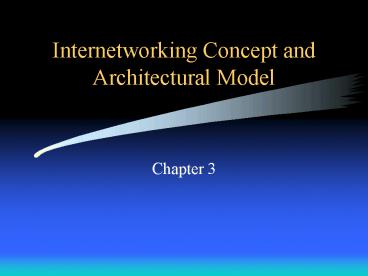Internetworking Concept and Architectural Model PowerPoint PPT Presentation
1 / 12
Title: Internetworking Concept and Architectural Model
1
Internetworking Concept and Architectural Model
- Chapter 3
2
Introduction
- Now that we know the technology that is used for
transmission, how do we create a coordinated unit
for communication? - Goal
- To hide details of the underlying network, and
build the necessary software to provide a
framework for communication - Two approaches to hiding details
- Application programs translate for their hardware
- Intermediate computers computers pass data, dont
look at it
3
Network Level Interconnection
- Small packets of data are sent from source to
destination without using intermediate
application programs - This separates the application from the transfer
of packets - It also allows the underlying network structure
to change without modifying the application - Separation of communication details from the
messages being sent
4
Design of communication systems
- No single network hardware technology can satisfy
all constraints - speed, distance, cost
- Users desire universal interconnection
- Therefore, we need a unified, cooperative
interconnection of (heterogeneous) networks which
supports a universal communication service
5
Design of communication systems
- New software, inserted between the
technology-dependent communication mechanisms and
application programs will make the collection of
networks appear to be a single large network
6
Design of the Internet
- Do not want to require users to understand the
hardware details - Do not want to mandate which hardware to use
- Do want to allow users to connect with computers
that are not directly connected - Do want to allow users to connect to all others
connected to the Internet (or an internet)
7
Internet Architecture
- How is one network connected to another?
- It involves more than just a cable the two
networks need to each be connected to a computer
that will pass packets between them - Called a router or a gateway See Figure 3.1
- Each router needs to know something of the
networks beyond those directly connected to it -
see Figure 3.2 - Each router needs to know the destination
network, not necessarily the actual computer
within the network - Routers in TCP/IP internets are usually small and
have little memory
8
The Users View
- Think of an internet as a single, virtual network
to which all machines connect, despite the
physical connections, as in Figure 3.3 - The network software is all that needs to be
reconfigured when to networks topology changes - Figure 3.3b shows that not all networks need to
be directly connected to all others (see the
routers) - The intermediate networks agree to handle traffic
in exchange for being connected themselves
9
All Networks are Equal
- A network is a network, regardless of whether it
is the smallest LAN or the largest WAN
10
Unanswered Questions
- What do the internet addresses look like?
- What does a packet look like?
- What happens when too many packets arrive too
quickly? - How can multiple application programs executing
concurrently on a single computer send and
receive packets to multiple destinations without
getting entangled?
11
Summary
- Interconnected systems agree to conventions so
that they can communicate with other computers - An internet allows two computers to communicate
even if they are not connected within the same
network, or directly connected networks - Computers must agree on a set of universal
identifiers and a set of procedures for moving
data - Connections between networks are made with
routers which attach to two or more networks - Routers forward packets from one network to
another
12
For Next Time
- Read Chapter 4
- See exercises, write your own notes

